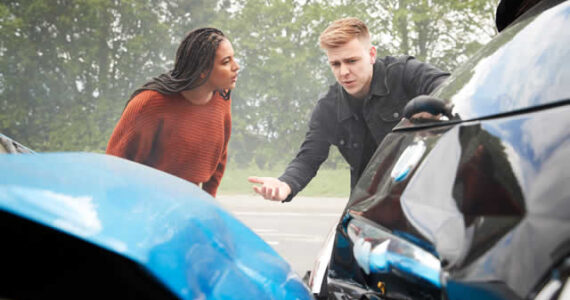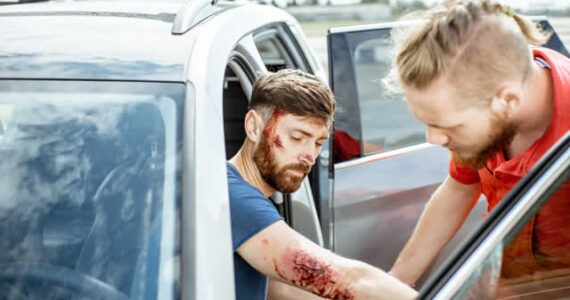The screech of tires, the jarring impact—a car accident is a stressful event. This stress can quickly escalate when the other driver disputes what happened, turning a straightforward situation into a confusing "he said, she said" scenario. You know they hit you, but they are adamant that you are to blame. What do you do?
Navigating a disputed liability claim can feel overwhelming, but knowing the right steps to take can protect your interests and help clarify the truth. This guide will walk you through the crucial actions to take at the scene, how to gather strong evidence for your auto collision claim, and how to work with insurance companies and legal professionals.
Following this advice will empower you to handle the situation calmly and effectively, ensuring the facts come to light.
Immediate Actions at the Scene
The moments following a collision are chaotic, but your actions here are critical in establishing what happened. Prioritizing safety, documenting the scene, and carefully exchanging information with the other driver will build a strong foundation for your claim. Let’s look at each of these steps.
-
Ensure Safety and Call the Authorities
Your first priority after any car accident is the well-being of everyone involved. Check yourself and your passengers for injuries. If it is safe to do so, move your vehicle out of the flow of traffic to a nearby shoulder or side road to prevent further collisions. Turn on your hazard lights to alert other drivers.
Once you are in a safe location, call 911 immediately. Reporting the accident is essential, especially when there are injuries, significant damage, or a dispute over fault. The responding police officers will create an official report, which is an invaluable piece of evidence.
Even in a minor accident, a police report provides an impartial account of the incident, and their initial assessment of the scene can be crucial in resolving a car accident fault dispute.
-
Document Everything
Evidence is your best friend when liability is contested. Use your smartphone to document the scene as thoroughly as possible. Take photos and videos from multiple angles, capturing the positions of the vehicles, the damage to both cars, skid marks on the road, traffic signs, and any relevant road conditions. The more visual evidence you have, the clearer the picture you can paint of the events that transpired.
Look for any witnesses who saw the accident. Politely ask for their names and contact information. An independent witness who can corroborate your version of events can be incredibly persuasive in a disputed liability case. Their neutral testimony can often break a stalemate between two conflicting stories.
-
Exchange Information
When speaking with the other driver, it is important to remain calm and stick strictly to the facts. Do not apologize or admit any fault, as these statements can be used against you later.
Politely exchange essential information, including names, addresses, phone numbers, driver’s license numbers, and insurance policy details. Be sure to get the make, model, and license plate number of the other vehicle as well.
Avoid getting into a debate about who was at fault. The side of the road is not the place to argue your case. Let the evidence and subsequent investigation determine liability. Your focus should be on gathering the necessary information and ensuring everyone is safe.
Gathering Evidence to Support Your Claim
After you have left the scene, your work to support your auto collision claim continues. The evidence you gather in the following days can strengthen your position and help your insurance company or attorney build a compelling case.
This includes obtaining the official police report, following up with witnesses, and documenting your vehicle’s damage in detail.
-
Obtain the Police Report
The police report is a cornerstone of your claim. It will contain the officer’s observations, diagrams of the accident scene, statements from both drivers, and sometimes, a preliminary determination of fault. You can typically request a copy from the police department that responded to the accident a few days after the incident. Review the report for accuracy and notify the police department of any errors you find.
-
Collect Witness Statements
If you were able to get contact information for witnesses at the scene, follow up with them as soon as possible while their memory is still fresh. Ask if they would be willing to provide a written or recorded statement describing what they saw. A detailed, signed statement from an unbiased third party can significantly influence the outcome of your disputed auto collision claim.
-
Review Your Vehicle’s Damage
The location and type of damage to both vehicles can often tell a story that supports your version of events. For example, damage to the rear of your car can help prove you were rear-ended. Take clear, detailed photos of the damage in good lighting before any repairs are made.
An estimate from a reputable auto body shop can also serve as professional documentation of the extent of the damage your vehicle sustained.
Working with Your Insurance Company
Once you have gathered your initial evidence, the next step is to engage with your insurance company. How you communicate and cooperate with them can have a significant impact on the resolution of your claim. This involves reporting the accident promptly, understanding your policy, and working with the adjuster.
-
Notify Your Insurer Promptly
Report the accident to your insurance company as soon as possible, even if you believe you are not at fault. Most policies require you to report any accident in a timely manner. When you speak with your insurer, provide them with all the information and evidence you have collected. A clear, factual account will help your adjuster begin their investigation on the right foot.
-
Understand Your Policy
Take the time to review your insurance policy to understand your coverage. Knowing the details of your collision, liability, and uninsured or underinsured motorist coverage will help you understand what to expect during the claims process. If you have any questions, do not hesitate to ask your insurance agent for clarification.
-
Cooperate with the Investigation
Your insurance company will assign an adjuster to investigate the claim. Cooperate fully with their investigation, providing any requested information and documentation. However, it is wise to be cautious in your statements.
Stick to the facts and avoid speculating. Remember that the adjuster’s goal is to resolve the claim, and your clear, consistent cooperation will help them advocate on your behalf.
Legal Options and Considerations
In some cases, especially those involving serious injuries or complex fault disputes, you may need to explore your legal options. Understanding when to seek legal counsel and knowing about concepts like comparative negligence can be critical. Here are some key legal considerations to keep in mind.
-
Consult with an Attorney
If you have been seriously injured, if the other driver’s insurance company is uncooperative, or if you simply feel overwhelmed by the process, it may be time to consult with a car accident attorney. An experienced attorney can manage all communication with the insurance companies, gather additional evidence, and ensure your rights are protected throughout the process.
-
Understand Comparative Negligence
Many states follow a "comparative negligence" rule, which means that fault can be shared between drivers. Under this system, your compensation may be reduced by your percentage of fault.
For example, if you are found to be 20% at fault, your settlement would be reduced by 20%. An attorney can help you understand how your state’s laws apply to your situation and build a case to minimize your assigned fault.
-
Consider Mediation or Arbitration
If you and the insurance company cannot agree on a settlement, mediation or arbitration may be viable alternatives to a lawsuit. In mediation, a neutral third party helps both sides negotiate a resolution.
In arbitration, a neutral arbitrator hears evidence from both sides and makes a binding decision. These processes can be less formal and expensive than going to court.
Protecting Yourself After a Collision
When you are involved in a car accident where fault is disputed, the path forward can seem daunting. By staying calm, prioritizing safety, and methodically gathering evidence, you can build a strong foundation for your claim.
Working transparently with your insurance company and seeking legal advice when necessary will provide you with the support you need to navigate the complexities of an auto collision claim. Remember that the truth is often found in the details, and your diligence can make all the difference in achieving a fair outcome.
image credit: envato.com


















